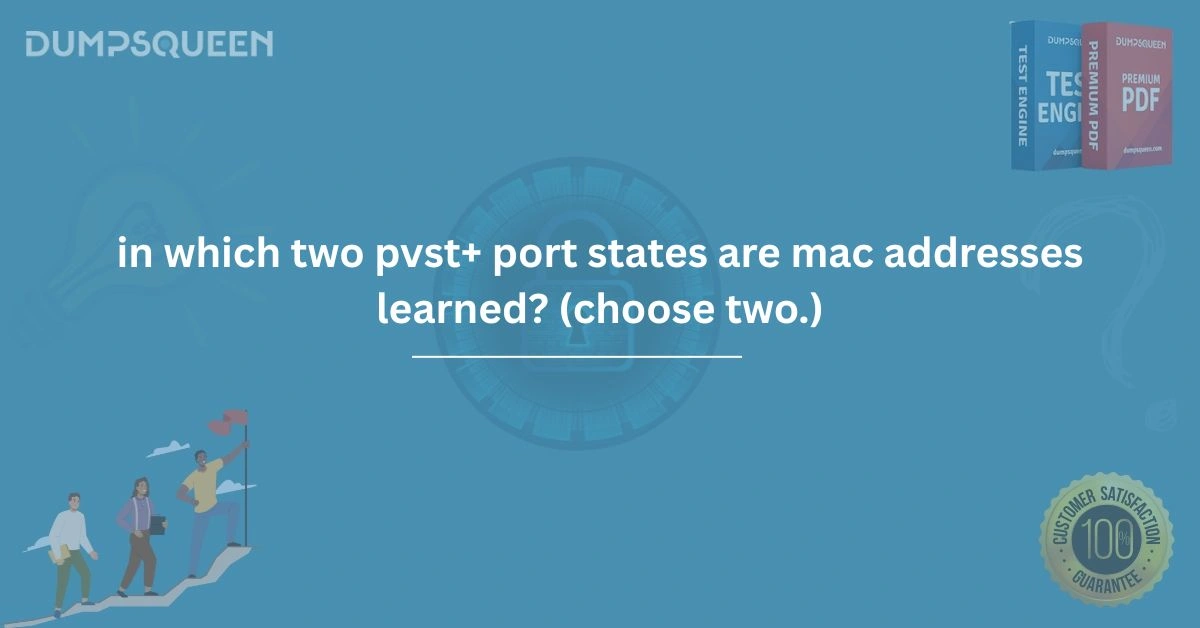Introduction
Modern computer networks rely on robust, flexible, and secure switching mechanisms to ensure smooth data transmission between devices. Among the critical technologies in switched networks is PVST+ (Per VLAN Spanning Tree Plus), a Cisco proprietary protocol that enhances network reliability by managing how traffic is forwarded and how loops are avoided. A key component of this process involves understanding how and when MAC (Media Access Control) addresses are learned. This article, presented by DumpsQueen, dives deep into the operational dynamics of PVST+, focusing specifically on the question: "In which two PVST+ port states are MAC addresses learned? (choose two.)" Through this comprehensive guide, network professionals, learners, and certification candidates will gain a strong grasp of PVST+ port behavior, switching logic, and how devices build their forwarding tables using MAC addresses.
What is PVST+?
Per VLAN Spanning Tree Plus (PVST+) is Cisco's enhancement of the IEEE 802.1D standard Spanning Tree Protocol (STP). Unlike the standard STP, which runs a single spanning tree for the entire network, PVST+ allows a separate instance of STP per VLAN. This design gives network engineers better control over traffic distribution and network redundancy across VLANs. Cisco developed PVST+ to support VLAN trunking protocols and compatibility with both legacy and modern equipment. It also introduced improvements in convergence times and network stability. Each VLAN's independent spanning tree allows for optimized load balancing and more granular control of how switches forward frames.
The Role of MAC Address Learning in Switching
To forward Ethernet frames efficiently, switches must understand where each device is located on the network. This knowledge comes from the MAC address learning process. When a switch receives a frame, it notes the source MAC address and the port it arrived on, storing that information in its MAC address table (also known as the forwarding table). This process helps the switch know exactly which port to use when it needs to send traffic back to a device with that MAC address. However, MAC address learning does not happen at all times or in all states of a port. Instead, it is restricted to specific operational port states, which are controlled by the spanning tree protocol.
PVST+ Port States Explained
Within PVST+, a switch port can exist in five primary states as it transitions between being inactive and fully forwarding traffic. These port states are:
-
Blocking
-
Listening
-
Learning
-
Forwarding
-
Disabled
Each of these states plays a specific role in maintaining a loop-free network topology and ensuring the integrity of Ethernet frame forwarding. Not all port states allow MAC address learning, and this distinction is critical for understanding switch behavior. Let us look at these port states in detail.
The Blocking State
In the blocking state, the port does not participate in frame forwarding and does not learn MAC addresses. It listens to BPDUs (Bridge Protocol Data Units) to detect loops but does not pass user data. This state exists solely for loop prevention. If a port is in blocking mode, it does not interact with the MAC address table.
The Listening State
When a switch port moves from blocking to listening, it begins the process of preparing to forward traffic. However, in the listening state, the port still does not learn MAC addresses. Its only task is to listen for BPDUs to ensure no loops are formed in the network.
The Learning State
The learning state is the first port state in which the switch begins to learn MAC addresses. While the port still does not forward user data in this state, it actively examines incoming frames and records their source MAC addresses into the MAC address table. This behavior enables the switch to build a map of device locations before it begins forwarding frames. This is one of the correct answers to the question: "In which two PVST+ port states are MAC addresses learned? (choose two.)" By learning MAC addresses in advance, the switch ensures a smooth transition to the forwarding state without introducing delays or requiring further learning after the port is active.
The Forwarding State
Once a port reaches the forwarding state, it begins to actively forward user traffic in addition to continuing MAC address learning. In this state, the switch performs all of its usual operations: it receives and forwards frames, learns MAC addresses, and sends and receives BPDUs. The forwarding state is the second correct answer to the keyword question. Therefore, MAC addresses are learned during the "learning" and "forwarding" port states.
The Disabled State
In the disabled state, the port is administratively shut down or is not in use. It neither forwards frames nor participates in the spanning tree process. There is no MAC address learning in this state, and the port remains inactive until re-enabled.
Answering the Question: In Which Two PVST+ Port States Are MAC Addresses Learned?
To directly answer the keyword-based question: "In which two PVST+ port states are MAC addresses learned? (choose two.)"
The correct answers are:
-
Learning
-
Forwarding
During these two states, the switch examines source MAC addresses from incoming frames and stores them in its MAC address table to optimize frame delivery. Understanding this concept is crucial for network engineers preparing for Cisco certifications like the CCNA (200-301) or other switching-focused exams.
Why This Matters for Certification and Real-World Networks
For professionals studying for Cisco exams, particularly the CCNA, questions regarding STP, PVST+, and MAC address learning frequently appear. DumpsQueen provides certification materials tailored to help learners retain this information and pass their exams on the first attempt. In real-world networking environments, knowledge of port states and MAC address behavior enables engineers to troubleshoot issues, fine-tune performance, and enhance network resilience. Incorrect assumptions about when MAC addresses are learned can lead to misconfigurations and security gaps.
Common Misconceptions About MAC Address Learning
It is a widespread misunderstanding that switches learn MAC addresses as soon as a port is up. In reality, until a port progresses past the listening stage and enters the learning or forwarding state, no MAC address learning occurs. Even though frames may be seen by the switch, they are ignored in terms of MAC table updates unless the port is in the proper state. This delay in learning is by design to ensure loop-free operation and proper convergence within the spanning tree.
Cisco Exam Insight from DumpsQueen
If you're using DumpsQueen’s materials to prepare for Cisco’s CCNA (200-301) or similar certifications, remember that the exam may test your understanding of both STP theory and practical application, including:
-
Recognizing port states
-
Understanding when MAC address tables are populated
-
Troubleshooting frame delivery issues in switching environments
These topics are all covered in DumpsQueen’s up-to-date exam dumps, practice tests, and detailed explanations.
Free Sample Questions
Question 1: In which two PVST+ port states are MAC addresses learned? (Choose two.)
A. Blocking
B. Listening
C. Learning
D. Forwarding
E. Disabled
Correct Answer: C. Learning and D. Forwarding
Question 2: Which PVST+ port state does not forward frames and does not learn MAC addresses?
A. Forwarding
B. Learning
C. Blocking
D. Disabled
Correct Answer: C. Blocking
Question 3: Why is MAC address learning disabled during the listening state in PVST+?
A. To reduce switch memory usage
B. To ensure BPDU transmission only
C. To avoid learning incorrect MAC addresses during topology changes
D. Because the port is administratively down
Correct Answer: C. To avoid learning incorrect MAC addresses during topology changes
Question 4: A switch port in forwarding state is receiving Ethernet frames. What two actions does it perform?
A. Drops all user data
B. Forwards frames
C. Learns MAC addresses
D. Sends shutdown signal
Correct Answer: B. Forwards frames and C. Learns MAC addresses
Conclusion
Mastering the behavior of PVST+ port states is essential for both certification candidates and networking professionals. Understanding in which two PVST+ port states MAC addresses are learned learning and forwarding is critical for network design, troubleshooting, and optimization. At DumpsQueen, we understand the importance of solid foundational knowledge, which is why we provide the most accurate and updated exam resources available. Whether you are studying for your CCNA certification or seeking to strengthen your practical networking skills, we’ve got you covered. Stay informed. Stay certified. Trust DumpsQueen.




